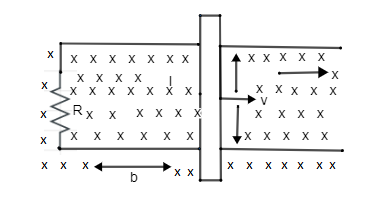Answer
396.9k+ views
Hint: This question is similar to concept motional EMF in loop by generated we can solve this question by using formula $\left| e \right|=\dfrac{d\phi }{dt}$ and right hand thumb rule and for section (C) we will use the formula of the power $P={{I}^{2}}R$ to solve the question.
Formula used:
$\phi =B.A$
$\phi $ = flux
B =magnetic field
A = area
$\left| e \right|=\dfrac{d\phi }{dt}$
e = EMF
$\dfrac{d\phi }{dt}$ = change in the flux
$P={{I}^{2}}R$
P = power dissipation across resistance
I = current in the circuit
R = resistance
Complete step by step solution:

A).If the conductor is moving in positive x – direction with the velocity v what the change in the flux in one sec is.
$\to $ It is given that the time for displacement is
t = 1sec
We know that formula for the velocity
$v=\dfrac{displacement}{t}$
Hence
Displacement = $vt$
In time t distance travelled by the conductor is as shown in the figure
$vt......\left( 1 \right)$
Now change in the flux
$\left| e \right|=\dfrac{d\phi }{dt}$
We know that the flux
$\phi =B.A$
$\begin{align}
& \dfrac{d\phi }{dt}=\dfrac{d(BA)}{dt} \\
& =A\times \dfrac{dB}{dt}.....(1) \\
\end{align}$
$\to $ Now for the area we will use the length l and distance travelled vt as shown in the figure.
$\to $So area,
$A=lvt.....\left( 2 \right)$
$\to $ Now substitute value of the equation (2) in equation (1)
$\left| e \right|=lvt\times \dfrac{dB}{dt}$
$\to $ Here magnetic field is constant across circuit
$\begin{align}
& \left| e \right|=l\times v\times 1\times B \\
& \left| e \right|=Bvl.....(3) \\
\end{align}$
B) Magnitude and the direction of the current
$\to $ We know that,
$I=\dfrac{\left| e \right|}{R}.....\left( 4 \right)$
$\to $ Now substitute value of the equation (3) in equation (4)
$I=\dfrac{Bvl}{R}....(5)$
$\to $ Now to know that direction of the current we will use thumb rule as magnetic field vertically downwards current direction will be
C) Power dissipation in the resistor:-
$\to $Power dissipation in resistor is given by below formula
$P={{I}^{2}}R.....(6)$
Now substitute value of the equation (5) in equation (6)
$\begin{align}
& P={{\left( \dfrac{Bvl}{R} \right)}^{2}}R \\
& P=\dfrac{{{B}^{2}}{{v}^{2}}{{l}^{2}}}{R} \\
\end{align}$
Note:
When we find direction of the current using the thumb rule we have to be careful of the direction of the magnetic field because in some cases it is vertically upwards.
Formula used:
$\phi =B.A$
$\phi $ = flux
B =magnetic field
A = area
$\left| e \right|=\dfrac{d\phi }{dt}$
e = EMF
$\dfrac{d\phi }{dt}$ = change in the flux
$P={{I}^{2}}R$
P = power dissipation across resistance
I = current in the circuit
R = resistance
Complete step by step solution:

A).If the conductor is moving in positive x – direction with the velocity v what the change in the flux in one sec is.
$\to $ It is given that the time for displacement is
t = 1sec
We know that formula for the velocity
$v=\dfrac{displacement}{t}$
Hence
Displacement = $vt$
In time t distance travelled by the conductor is as shown in the figure
$vt......\left( 1 \right)$
Now change in the flux
$\left| e \right|=\dfrac{d\phi }{dt}$
We know that the flux
$\phi =B.A$
$\begin{align}
& \dfrac{d\phi }{dt}=\dfrac{d(BA)}{dt} \\
& =A\times \dfrac{dB}{dt}.....(1) \\
\end{align}$
$\to $ Now for the area we will use the length l and distance travelled vt as shown in the figure.
$\to $So area,
$A=lvt.....\left( 2 \right)$
$\to $ Now substitute value of the equation (2) in equation (1)
$\left| e \right|=lvt\times \dfrac{dB}{dt}$
$\to $ Here magnetic field is constant across circuit
$\begin{align}
& \left| e \right|=l\times v\times 1\times B \\
& \left| e \right|=Bvl.....(3) \\
\end{align}$
B) Magnitude and the direction of the current
$\to $ We know that,
$I=\dfrac{\left| e \right|}{R}.....\left( 4 \right)$
$\to $ Now substitute value of the equation (3) in equation (4)
$I=\dfrac{Bvl}{R}....(5)$
$\to $ Now to know that direction of the current we will use thumb rule as magnetic field vertically downwards current direction will be
C) Power dissipation in the resistor:-
$\to $Power dissipation in resistor is given by below formula
$P={{I}^{2}}R.....(6)$
Now substitute value of the equation (5) in equation (6)
$\begin{align}
& P={{\left( \dfrac{Bvl}{R} \right)}^{2}}R \\
& P=\dfrac{{{B}^{2}}{{v}^{2}}{{l}^{2}}}{R} \\
\end{align}$
Note:
When we find direction of the current using the thumb rule we have to be careful of the direction of the magnetic field because in some cases it is vertically upwards.
Recently Updated Pages
How many sigma and pi bonds are present in HCequiv class 11 chemistry CBSE

Why Are Noble Gases NonReactive class 11 chemistry CBSE

Let X and Y be the sets of all positive divisors of class 11 maths CBSE

Let x and y be 2 real numbers which satisfy the equations class 11 maths CBSE

Let x 4log 2sqrt 9k 1 + 7 and y dfrac132log 2sqrt5 class 11 maths CBSE

Let x22ax+b20 and x22bx+a20 be two equations Then the class 11 maths CBSE

Trending doubts
Fill the blanks with the suitable prepositions 1 The class 9 english CBSE

At which age domestication of animals started A Neolithic class 11 social science CBSE

Which are the Top 10 Largest Countries of the World?

Give 10 examples for herbs , shrubs , climbers , creepers

Difference between Prokaryotic cell and Eukaryotic class 11 biology CBSE

Difference Between Plant Cell and Animal Cell

Write a letter to the principal requesting him to grant class 10 english CBSE

Change the following sentences into negative and interrogative class 10 english CBSE

Fill in the blanks A 1 lakh ten thousand B 1 million class 9 maths CBSE




